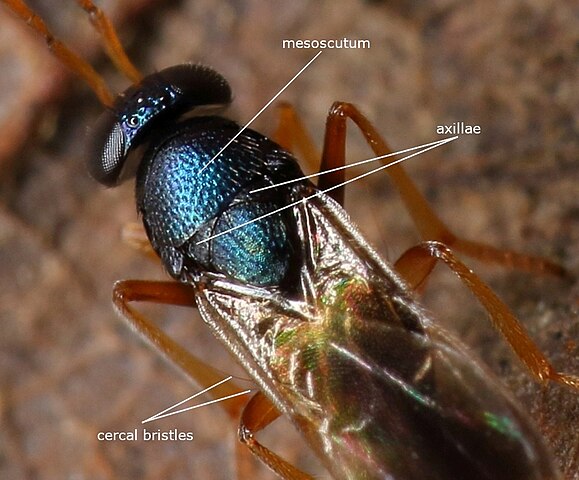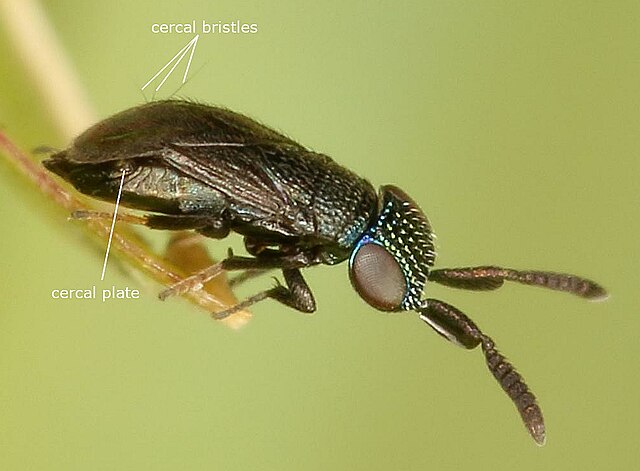Identification of encyrtid wasps
Encyrtidae is a family of small (< 5 mm) parasitic wasps. These are fairly easy to identify to family level (with reasonable-quality photos), but it is far more difficult to find the genus, unless the individual is from one of the few genera that are easily recognised.
These are features of the family:
- Large mesopleuron, usually covering more than half of the thorax (mesosoma) in side view.
- Mid coxae join the thorax near the middle of the mesopleuron.

Encyrtid parasitic wasp - lateral view. https://commons.wikimedia.org/wiki/File:Encyrtidae_lateral_view_with_annotations.jpg
- Mesoscutum transverse (width greater than length), and generally not segmented by notauli.
- The axillae are usually visible as triangles with two long sides, one adjacent to the mesoscutum and the other adjacent to the scutellum; the short side of the triangle is adjacent to the base of the forewing. The axillae touch, or nearly touch, medially; appearing as wedges between the mesoscutum and the scutellum.

Encyrtid parasitic wasp - dorsal view. https://commons.wikimedia.org/wiki/File:Encyrtidae_dorsal_view_with_annotations.jpg
- Cercal plates (at the base of the cercal bristles) are advanced; rather than being near the posterior tip of the metasoma (abdomen); they are usually within the anterior (front) two-thirds of the metasoma.

Encyrtid parasitic wasp - dorso-lateral view. https://commons.wikimedia.org/wiki/File:Encyrtidae_dorso-lateral_view_with_annotations.jpg
- In Encyrtidae with fully developed wings, the marginal vein of the forewing is usually shorter than stigmal vein; there is also an oblique band on the forewing that lacks setae (a linea calva).

Forewing of Anagyrus minipedicellus - from Zu, G. H., Zhang, X., & Zhang, Y. Z. (2018). A new species of Anagyrus (Hymenoptera, Encyrtidae) from Malaysia, parasitoid of Lanceacoccus sp.(Hemiptera, Pseudococcidae). Journal of Hymenoptera Research, 65, 141-148. https://commons.wikimedia.org/wiki/File:Forewing_of_Anagyrus_minipedicellus_from_Malaysia_Fig7_Zu_et_al_2018.jpg
There is a key to the Afrotropical encyrtid genera (Prinsloo and Anneke, 1979 https://journals.co.za/doi/pdf/10.10520/AJA00128789_2641), but effective use of the key usually needs a specimen under a microscope. I am in the process of using the key as a basis for a guide that includes photographs, created mainly to see whether I can get my head around the group (I'm still floundering). The guide (https://en.wikiversity.org/wiki/African_Arthropods/Afrotropical_Encyrtidae_Key) is on Wikiversity as part of a project called "African Arthropods" (https://en.wikiversity.org/wiki/African_Arthropods).
Please feel free to edit or add to the Wikiversity project.




Comentarios
Very nice! Thank you @alandmanson
Thanks Alan!
Nice page. I'm surprised I don't see more about the cercal bristles in the documents I've seen so far. Can they not be useful in identification?
Thanks Victor;
Advanced "cercal plates" are mentioned in the Universal Chalcidoidea Database (https://www.nhm.ac.uk/our-science/data/chalcidoids/encyrtidae.html) and the advanced "cercus" is mentioned in Gibson's key (Goulet, H. and Huber, J.T. eds., 1993. Hymenoptera of the world: an identification guide to families. Canada Communication Group - Publishing, Ottawa. p.581).
Where they go, the cercal bristles follow!
Yeah, but in photos the bristles are often clearly visible and the plates not so much.
That is part of the reason for doing the page - most keys or ID guides are written for a specimen under the microscope; I'm trying to learn how to ID photos, and hopefully I can help some others along the road.
Agregar un comentario